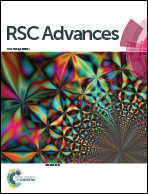Fabrication of functionalized 3D graphene with controllable micro/meso-pores as a superior electrocatalyst for enhanced oxygen reduction in both acidic and alkaline solutions†
Abstract
We have synthesized hierarchically 3D porous Fe5C2/N-doped graphene (3D Fe5C2/N-PG) with numerous micro/meso-pores by a controllable and facile strategy. The density of the micro/meso-pores can be accurately tailored by adjusting the reaction conditions. It is found that the ORR performance of the electrocatalyst is strongly dependent on the pore structures under the same conditions. The electrocatalyst exhibits comparable activity in an acidic solution together with superior activity in an alkaline solution to the state-of-the-art Pt/C catalyst in terms of onset potential, half-wave potential, diffusion-limiting current density and kinetic current density. The excellent electrocatalytic activity is attributed to the balance of the surface area, hierarchical porosity, chemical composition (pyridinic N, graphitic N and Fe5C2 nanoparticles) and conductivity of the 3D interconnected graphene. This strategy for the tunable synthesis of hierarchically 3D porous graphene materials offers a platform for developing catalysts with superior activity in energy devices.


 Please wait while we load your content...
Please wait while we load your content...